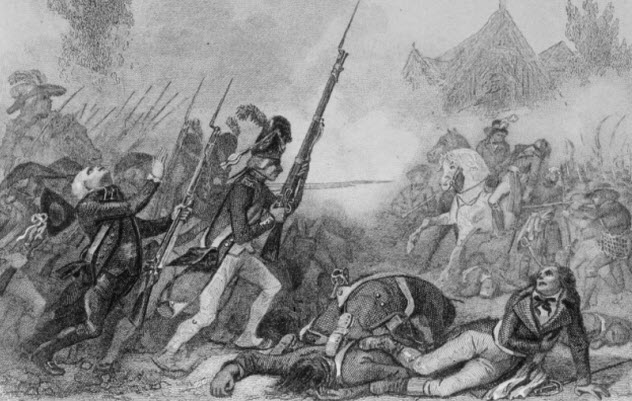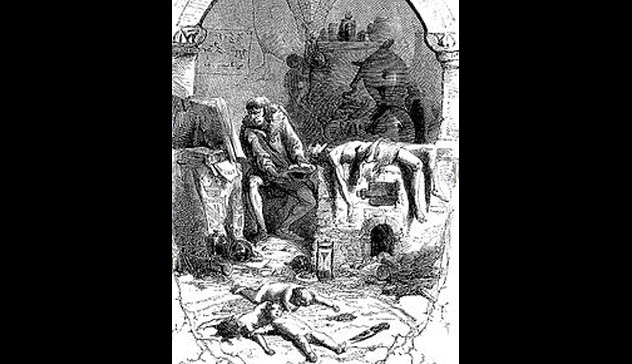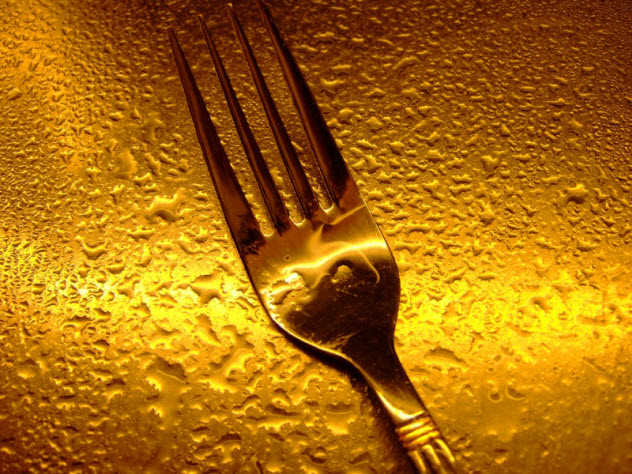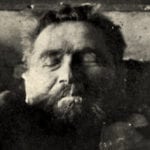So begins Patrick Suskind’s classic novel Perfume: The Story Of A Murderer, which tells the story of Jean-Baptiste Grenouille, an ambiguously human peasant who is driven to kill to satisfy his powerful sense of smell. The novel is considered fantasy, yet a truly gifted and abominable man did live in 18th-century France. He was known as Tarrare, and he was always hungry.
10Enfant Terrible
In the early 1770s, a monster was born in the lush countryside of the Rhone valley, not too far from the booming silk-weaving town of Lyon. We know little about his early life, save that he left his parents’ home at a young age. Perhaps they drove him out, frightened or drained by their strange son and his insatiable appetite. Or perhaps the hunger compelled him to strike out on his own, to seek greater supplies of food than his rural background could provide. We’re not even sure of his real name, although he was later known as Tarrare, from a term for flatulence or from the Rhonish region of Tarare. (Or both. Or neither.) But we do know that there was something terribly wrong with Tarrare from a young age. Despite eating amounts of food that would have killed a normal man, a hunger Tarrare could never quell gnawed at him constantly. At age 17, he weighed just 48 kilograms (100 lb) and could already consume one-quarter of his body weight in beef during a single meal. He ate wax and corks and offal and worse things. But they did him no harm, and he relished rotting flesh as much as the finest meals. After leaving his parents, he moved from town to town, begging and scavenging and stealing what he could. In his late teens, he arrived in Paris, then the greatest city in Europe, where he resolved to stay.
9Snake-Eater
In Paris, Tarrare found his calling as a street performer, joining one of the many disreputable troupes that competed for space on the city’s narrow boulevards. He would challenge the crowd to best his appetite, and he rarely lost the challenge. On one happy occasion, he consumed a giant basket of apples provided by a spectator. Less generous audiences demanded that he wolf down rocks, which he often did. At this, even his fearsome digestive system failed, and he was frequently carried to the famous Hotel-Dieu hospital to be treated for intestinal blockages. However, as soon as he had recovered, “he resumed his former practices and was once detected on the point of swallowing the surgeon’s watch, with its chain and seals.” He desisted after the surgeon informed him that any swallowed valuables would be retrieved with a sword. But he couldn’t control himself for long and soon returned to busking on the streets of Paris, where he created a sensation by swallowing snakes and eels whole, although careful observers suspected that he crushed their skulls with his teeth before they slipped down his gullet.
8An Unusual Anatomy
Time passed, and Tarrare soon reached adulthood. Though his appearance had apparently been normal as a child, he now looked so different from ordinary men as to be unsettling. His mouth and esophagus were so enormous that when he leaned his head back, a cylinder of 30 centimeters (1 ft) in diameter could be lowered into his throat. His lips were thin to the point of invisibility, stretched over teeth stained a horrible brown. His cheeks hung loosely on his face, and it was said that he could fit a dozen eggs in them with ease. His complexion was unhealthy and his hair thin and fine. Despite his eating habits, he remained thin and frail. His most remarkable feature was his stomach, which was so distended that it hung from him like an apron. When he hadn’t eaten in some time, it was said that he could wrap his belly almost around himself. Doctors who studied him found that he was always sweating and his body was fevered and hot to the touch, to the point that some claimed to see a vapor rising off him. He appeared to have a natural stench that no amount of bathing could cure and often reeked so badly that no one could bear to be near him. As he aged, his molars were worn away by constant and unusual use, although this seemed to have no effect on his appetite. He was plagued by diarrhea, the results of which were considered “fetid beyond all conception” by even experienced medics.
7A Rhonish Renfield
But if Tarrare’s ordinary appearance was unusual, the sight of him eating was considered downright unsettling. He would assume a frenzied appearance, and his sweating would increase, while “his cheeks and eyes became of a vivid red.” He was quick and active when hungry, which included immediately after eating a normal-sized meal. However, once he had gorged himself, he would be overcome by the desire to sleep or else fall into a sort of trance in which he stared ahead, belching and swallowing. He would snatch birds from the trees to eat them, and he could vomit up indigestible hair and fur, not unlike the pellets of an owl. Under the gaze of an astonished doctor, he seized a cat that had strayed too close, tore open its stomach with his teeth, and drank its blood. He then consumed the remainder of the corpse, regurgitating the fur later. As his appetite grew, he increasingly preyed on small animals in this way, until his arrival in a neighborhood would be preceded by a rush of stray dogs that had learned to flee in terror of Tarrare. Baron Percy, a noted surgeon who became his principal doctor and biographer, regarded him with a mix of horror and pity: “Let a person imagine all that domestic and wild animals, the most filthy and ravenous, are capable of devouring, and they may form some idea of the appetites, as well as of the wants of Tarrare.”
6Tarrare The Soldier
In 1788, with the French Revolution in full swing, Tarrare decided to leave the dangerous streets of Paris and join the army. Perhaps, as some have suggested, he was “caught by the spirit of the Revolution.” On the other hand, the upheaval in France triggered severe food shortages in the capital, so perhaps Tarrare merely hoped to secure regular meals. Military rations, adequate for a normal person, did nothing to sate his monstrous appetite. Yet he survived for a while by working as a servant to his fellow soldiers in exchange for a share of their portions. But when the army was sent to the front, his comrades had nothing to spare, and Tarrare began to starve. After collapsing from hunger, Tarrare was taken to a military hospital where the alarmed doctors ordered that he be given four times the normal rations. It wasn’t enough, and he soon stalked the corridors of the hospital, feeding ravenously on kitchen scraps and spoiled food refused by pickier patients. Even this was unsatisfactory, and he eventually began consuming poultices and other medical supplies. By now, his doctors were more intrigued that exasperated. Eventually, a Dr. Courville observed the hospital porters fighting to restrain Tarrare from a meal prepared for some German laborers working nearby. Immediately, he ordered the porters to release Tarrare and challenged him to eat as much as he could. The meal was intended to feed 15 men, but Tarrare fell on it at once, consuming two huge meat pies, large platters of grease and salt, and 8 liters (2 gal) each of milk and curdled milk. Only when the table was bare did he stop and fall into a deep sleep, satisfied at last. Having pacified the irate laborers, Courville was intrigued to observe that the loose skin of Tarrare’s stomach was now stretched like a balloon. Impressed, Courville began to wonder if this rare talent could be put to use in the war effort.
5Tarrare The Spy
Once Tarrare’s hunger had returned, Courville persuaded him to swallow a small wooden box with a note sealed safely inside. The box reemerged the following day, having passed safely through his cavernous digestive tract. At once, Courville contacted the high command and informed them that he had discovered a foolproof method of passing messages behind enemy lines. A general was dispatched and watched in stunned silence as Tarrare consumed 15 kilograms (30 lbs) of raw liver. With his powers thus demonstrated, Tarrare was instructed to swallow another wooden box. Inside were crucial secret documents which he was to convey to a French colonel taken prisoner by the Prussians. At least, that was what Tarrare was told. In truth, the general had been underwhelmed by the plan and unimpressed by the glutton’s mental abilities. The general decided on a test, placing in the box only unimportant papers that would do no harm if captured by the enemy. It was just as well, since no sooner had Tarrare arrived in Landau than he gave himself away and was captured by the Prussians. Perplexed by this strange spy, the Prussians whipped Tarrare until he confessed the details of his mission. Then they tied him to a privy until he voided the wooden box. Enraged to find the message was inconsequential, they marched Tarrare to the gallows and subjected him to a mock execution. Shaken, Tarrare returned to France, determined to put his career as a spy behind him.
4Gilles De Rais
His near-death experience at the hands of the Prussians seemed to have shaken Tarrare. He began to beg his doctors to cure him, convinced that his ever-growing hunger would be the end of him in one way or another. His case was taken up by Baron Percy, a medical man of considerable repute. Percy tried acids, opium, tobacco pills, and even soft-boiled eggs (reputed to quell appetites in the Levant). But nothing worked, and Tarrare grew increasingly ravenous. He sneaked out to slaughterhouses and refuse-strewn alleys, fighting “with dogs and wolves for their filthy food.” For the first time, he began to drink human blood, drawn from his fellow patients for medical reasons. He broke into the hospital mortuary and feasted on the dead as eagerly as he had once consumed stray cats. Those who had regarded him as a curiosity began to regard him with fear and revulsion. Then the unthinkable happened. An infant, just 14 months old, disappeared while being treated in the hospital. Nobody knew what had happened, but eyes soon turned to Tarrare, with his thin lips and stained teeth. Tarrare, the cannibal, with his uncontrollable need to feed, who was known to lurk through the ward hunting for food. There was only one conclusion. Wisely, Tarrare chose to disappear from the hospital and from Paris.
3A Golden Fork
For four years, the vampire roamed through France, absent from the historical record. Where did he go? Who gave him shelter? How did a ghoul, an eater of the dead and perhaps the living, assuage his gnawing hunger in the lean times of revolutionary France? Did he feast on the priests drowned and left to float downriver at Nantes? Was he watching in the crowd as Robespierre went to the guillotine or lurking behind Turreau’s columns as they massacred their way through the Vendee? No one can say. The only one searching for him was Baron Percy, who didn’t find Tarrare until early 1798 when he was admitted to a hospital in Versailles. Percy arrived to find that Tarrare was dying, plagued by constant diarrhea and an unknown condition that had finally cured his appetite, a mixed blessing that he could take no comfort in. The vampire was in a state of great distress, telling Percy that he had swallowed a golden fork, which he was sure was killing him from the inside. But the fork never reappeared, and doctors actually thought that Tarrare had contracted tuberculosis. Percy did what he could, but the situation was hopeless. Tarrare died in agony a month later. Doctors estimated that he was just 26.
2Tarrare The Corpse
Death was to provide few answers as to what exactly Tarrare was. In fact, the case became even stranger because his body immediately “became prey to a horrible corruption” and began to putrefy at an alarming rate. His horrendous smell had grown so awful that even doctors hardened by the carnage of the revolution were reluctant to attempt an autopsy. Presumably, their lack of enthusiasm only grew after they sliced into his stomach and found his organs “immersed in pus.” Still, they pressed on, with Percy noting that Tarrare’s liver was gigantic, although it had already begun to liquefy into “a putrescent state.” He also observed that “the gallbladder was of considerable magnitude” and that “the stomach, in a lax state, and, having ulcerated patches dispersed about it, covered almost the whole of the abdominal region.” Unfortunately, at that point “the stench of the body was so insupportable that M. Tessier, chief surgeon of the hospital, could not carry his investigation to any further extent.” The body was quickly buried and hopefully never troubled the world again.
1A Medical Mystery
So how to explain the strange condition that plagued the man known as Tarrare? He is often compared to his contemporary Charles Domery, a Prussian soldier who was reputed to eat cats, candles, and several pounds of grass a day. It was said that Domery’s comrades once had to wrestle a severed leg away from him as he tried to eat it on the battlefield. What could explain such manic hunger, a gnawing pain severe enough to turn men into monsters? The sad truth is that modern science really has no idea. Excessive eating is known in certain mental patients but never to such a disturbing degree. Experiments have found that a damaged amygdala can cause cats to eat to excess, while a damaged hypothalamus has the same effect on lab rats. However, in both cases, the animals soon became obese, while neither Tarrare nor Domery was ever known to be particularly overweight. In fact, Tarrare was said to be positively skeletal for much of his life. Additionally, the rats eventually got better. Although brain damage might have played a part, it can’t be the only explanation for Tarrare’s unusual biology. Hyperthyroidism can result in an extremely fast metabolism, prompting hunger with little weight gain. But no case of hyperthyroidism has ever produced anything like Tarrare. Perhaps the story is simply exaggerated, although most of the details are corroborated by Baron Percy, a surgeon of considerable repute with little reason to lie. The case will likely remain a mystery unless another Tarrare emerges from some obscure corner of the world.























